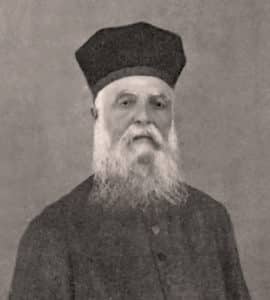The Jewish communities of the Ottoman Empire operated as self-governing bodies, known as “millets“. The Jews of Rhodes organized and conducted their communal life according to the teachings of the Jewish traditions.
Because they were so involved with Jewish law and custom, it was necessary for them to have teachers and scholars who could interpret and clarify the requirements of these laws. Consequently, the rabbinic authorities were held in high regard and respect.
The Kahal Grande (Kahal Kadosh Gadol) of Rhodes before its destruction in WWII.
A “Chief Rabbi” was assigned to lead the rabbinic authorities. For centuries, the small Sephardic community of Rhodes was fortunate in having a number of additional religious scholars. There were many rabbis and “hahams” in Rhodes to serve the community.
Rhodes was always known for its traditional observance of Judaism. In fact, from 1927 to 1937, Rhodes maintained a Rabbinical College which served the Aegean Sea area.

The Chief Rabbi of Rhodes from 1922 to 1932 was Reuben Eliahu Israel. He was the 12th descendant of the same religiously prominent family to serve as Rabbis, a succession which lasted over 200 years. Rabbi Israel devoted a great part of his life to the translation in Ladino (Judeo-Spanish) of psalms, proverbs, poems and religious works, such as the “Kryiat de Izhak” (The Sacrifice of Isaac) and the “Pirke Avot” (The Sayings of Our Fathers).

In 1936 to 1939, Rabbi Michel Albagli served as the Chief Rabbi. He eventually left Rhodes to serve the Jewish communities in the US.
The Rabbinical College
For centuries, the Jewish community of Rhodes held an important position both religiously and geographically. It was home to the Romaniot Jewish community and later to the Sephardic Jewish community. It was an “in-between” position for various Jewish communities of the Aegean Sea and Europe to the Holy Land. It also developed an increased measure of importance relating to questions (“responsas”) for interpreting Jewish laws and practices.
In 1928 the Rabbinical College was established as the natural need for the development of a center for spiritual learning. The school attracted professors and students from several countries and earned an international reputation. Its graduates have played important roles in several Jewish communities.
Originally, the Rabbinical College was located in the Old City of Rhodes in the Jewish Quarter. Later it was moved to larger premises in the New City of Rhodes.
In 1938 the College was closed down when the anti-Jewish laws were passed by the Governor of Rhodes. In its relatively short existence, it had become one of the leading rabbinical seminaries among Sephardic communities.
1934 Rabbinical College of Rhodes
1934 Diploma
The 3 Locations of the Rabbinical College
The first location was within the Jewish Quarter of the Old City and the last two were in the New City.
1934 list of the Rabbinical students of Rhodes and their city of origin:
| Name | City |
|---|---|
| Aboulafia, Haim | Izmir |
| Angel, Aharon | Bourgas |
| Camhi, Jacques | Alexandria |
| Capelouto, Moise | Island of Cos |
| Capelouto, Raphael | Rhodes |
| Cohen, Herzl | Rhodes |
| Cohen, Samuel | Izmir |
| Fintz, Albert | Andrinople |
| Hanan, Robert | Rhodes |
| Harari, David | Alexandria |
| Iakoel, Moise | Alexandria |
| Israel, Moise | Rhodes |
| Kamri, Henri | Cairo |
| Levy, Moise | Rhodes |
| Levy, Samuel | Rhodes |
| Menashe, Haim | Rhodes |
| Romano, Maurice | Sarajevo |
| Sidis, Michel | Rhodes |
| Sutton, Mourad | Aleppo |
| Taraboulos, Jacque | Cairo |

1932 of the funeral procession of Chief Rabbi Reuben Eliahu Israel.
The Extraordinary Israel Family Rabbinical Lineage
There was a unique family on the island of Rhodes which provided the Jewish community with a lineage of rabbis, all coming from the Israel family.
Please find below two charts of this family which has been compiled by Leon Taranto.
Tombs of the Rabbis
In the Jewish cemetery of Rhodes there is a separate section reserved for the Rabbis. After entering the cemetery, it is the row of tombstones located immediately on the left after entering the cemetery. View: Rabbi tombstones and their inscriptions
Rhodes Jewish Historical Foundation